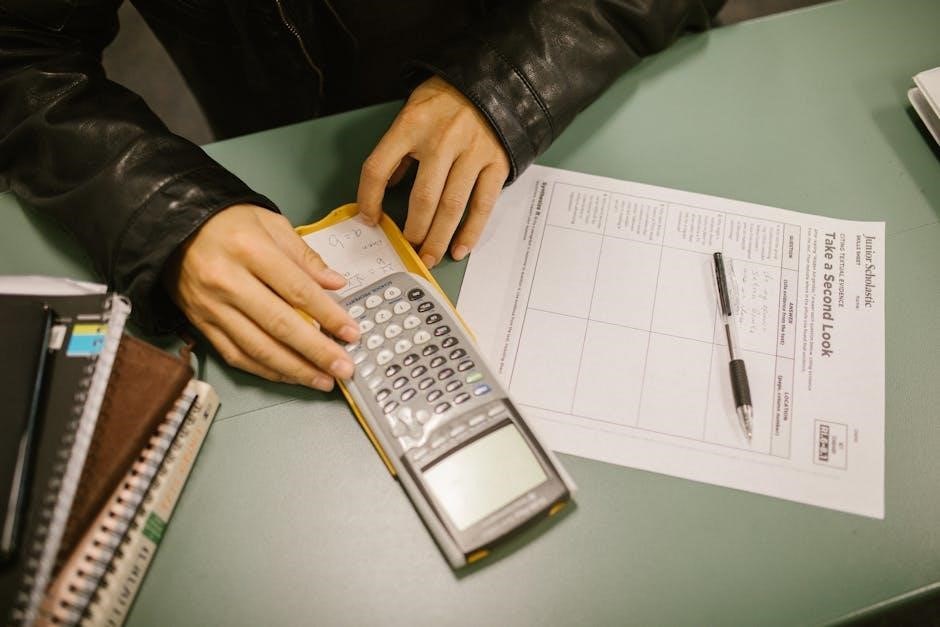Year 8 maths tests assess student understanding of key mathematical concepts, ensuring readiness for higher-level studies. Regular practice with PDF tests enhances problem-solving skills and builds exam confidence.
Overview of Year 8 Maths Assessments
Year 8 maths assessments are designed to evaluate students’ understanding of essential mathematical concepts, ensuring they are well-prepared for advanced studies. These tests typically last 45 to 60 minutes and include a variety of question types, such as multiple-choice, short-answer, and long-answer questions. They cover key topics like rational numbers, linear equations, and quadrilaterals. Resources like PDF test papers provide students with practice opportunities to familiarize themselves with the exam format and improve problem-solving skills. Regular assessments help identify strengths and areas for improvement, enabling students to focus their revision effectively. Additionally, these tests prepare students for the structure and timing of higher-level examinations, fostering confidence and readiness.
Importance of Practicing with PDF Tests
Practicing with PDF tests is crucial for Year 8 maths students as it provides hands-on experience with exam-style questions, helping to build confidence and familiarity with the test format. These resources often include multiple-choice questions, case study-based problems, and short-answer tasks, mirroring real assessments. Regular use of PDF tests allows students to identify weak areas, refine problem-solving strategies, and improve time management skills. Additionally, PDF tests are easily accessible and can be used repeatedly, making them an invaluable tool for consistent practice. By simulating exam conditions, PDF tests help students develop a clear understanding of what to expect, reducing anxiety and enhancing overall performance. Regular practice with these materials ensures a strong foundation for success in Year 8 maths assessments.

Structure of a Year 8 Maths Test
A Year 8 maths test typically includes multiple-choice questions, short-answer problems, and case study-based tasks. Tests are divided into clear sections, with a set duration for completion.
Test Duration and Format
Year 8 maths tests typically range from 45 to 60 minutes, depending on the institution. The format includes multiple-choice questions, short answers, and problem-solving tasks. Students are often allowed to use calculators for specific sections, with instructions to present answers in designated spaces. Diagrams must be drawn in pencil, and tracing paper is permitted for complex calculations. Clear instructions are provided at the beginning, emphasizing the use of black ink for written responses. Time management is crucial, as tests are designed to assess both accuracy and efficiency. The structured format ensures students can navigate through questions methodically, with sufficient time allocated to each section. Proper adherence to instructions is essential for optimal performance.

Types of Questions Included
Year 8 maths tests feature a variety of question types to assess different skills. Multiple-choice questions test quick recall and conceptual understanding, while short-answer questions require concise problem-solving. Long-answer questions evaluate detailed reasoning and step-by-step solutions. Case study-based questions apply mathematical concepts to real-world scenarios, enhancing practical problem-solving abilities. Additionally, questions may involve creating or interpreting graphs, charts, or diagrams to demonstrate spatial and analytical skills. The inclusion of both numerical and word problems ensures a comprehensive assessment of mathematical proficiency. Calculations and mental maths questions are also integrated to gauge computational accuracy and efficiency. This diverse range of questions ensures a holistic evaluation of a student’s mathematical knowledge and application capabilities.
Marking Scheme and Weightage
The marking scheme for Year 8 maths tests is designed to evaluate accuracy, problem-solving skills, and detailed reasoning. Multiple-choice questions are typically worth 1 mark each, while short-answer questions carry 2-3 marks depending on complexity. Long-answer questions, requiring step-by-step solutions, are allocated 4-5 marks. Case study-based questions often have higher weightage, up to 10 marks, as they assess in-depth analysis and practical application. The total test marks vary, but weighting focuses on key topics like rational numbers, linear equations, and quadrilaterals. Partial marks are awarded for correct methods, even if the final answer is incorrect. This system ensures fairness and encourages students to demonstrate their reasoning process.

Key Topics Covered in Year 8 Maths Tests
Rational numbers, linear equations, and understanding quadrilaterals are core areas. Fractions, decimals, and percentages are also emphasized, developing problem-solving skills and mathematical reasoning.

Rational Numbers and Operations
Rational numbers are a fundamental concept in Year 8 maths, focusing on integers, fractions, and decimals. Students learn to add, subtract, multiply, and divide these numbers, ensuring a solid grasp of number operations. Simplifying expressions and solving equations involving rational numbers are key skills assessed. Proper use of negative indices and understanding of reciprocals are also emphasized. Practice tests highlight common mistakes, such as misapplying signs or miscalculating fractions. Mastering these operations is crucial for success in higher-level maths. Regular practice with PDF tests helps students build confidence and accuracy in handling rational numbers.
Linear Equations in One Variable
Linear equations in one variable are a core component of Year 8 maths, focusing on solving for unknowns. Students learn to simplify expressions, balance equations, and solve for variables using inverse operations. Key skills include handling equations with positive and negative numbers, fractions, and decimals. PDF tests often include word problems requiring translation into algebraic form. Common mistakes involve incorrect sign handling and misapplying operations. Regular practice helps students build fluency and problem-solving strategies. Emphasis is placed on clear, step-by-step solutions, ensuring a strong foundation for advanced algebraic concepts.
Understanding Quadrilaterals
Quadrilaterals are four-sided polygons, and understanding their properties is crucial for Year 8 maths. Students learn to identify and classify different types, such as squares, rectangles, rhombuses, parallelograms, trapezoids, and kites. Key concepts include properties of sides, angles, and diagonals. For example, rectangles have four right angles, while parallelograms have opposite sides equal. Solving problems involving perimeter and area of quadrilaterals is also emphasized. Theorems related to quadrilaterals, such as the properties of rectangles and rhombuses, are explored. PDF tests often include questions requiring identification, calculation, and application of these properties. Regular practice helps students master geometric concepts and apply them to real-world problems.
Fractions, Decimals, and Percentages
Fractions, decimals, and percentages are fundamental concepts in Year 8 maths, enabling students to understand proportional relationships and solve real-world problems. These topics involve converting between forms, simplifying expressions, and applying operations. For instance, students learn to convert fractions to decimals and percentages, and vice versa. They also practice solving equations and word problems involving these concepts. PDF tests often include questions that require converting fractions to decimals, calculating percentages, and solving proportional problems. Regular practice with these exercises helps students build fluency and accuracy. Mastery of these skills is essential for advanced maths topics and practical applications in fields like finance and science.

Preparation Strategies for Year 8 Maths Tests
Effective preparation for Year 8 maths tests involves using revision packs, practicing past papers, and creating mind maps to master key concepts. Regular calculator practice also enhances problem-solving efficiency.
Using Revision Packs and Resources
Revision packs are essential for structured Year 8 maths test preparation. They include concise notes, practice questions, and past paper examples, covering key topics like fractions, decimals, and quadrilaterals. Regular use helps identify weak areas, allowing targeted practice. Additionally, online resources provide interactive exercises and video tutorials for better concept understanding. Utilizing these tools ensures comprehensive coverage of the syllabus and improves problem-solving skills. By incorporating revision packs into daily study routines, students can build confidence and achieve better test results. These resources also include tips for effective time management and strategies to tackle different question types, making them invaluable for exam success.
Practicing with Past Papers
Practicing with past papers is a highly effective way to prepare for Year 8 maths tests. These papers provide real exam questions, helping students familiarize themselves with test formats and question types. Regular practice with past papers improves time management and reduces exam anxiety. Students can identify recurring topics, such as fractions, decimals, and linear equations, and focus on mastering these areas. Past papers also highlight common mistakes, allowing learners to correct them before the actual test. By simulating exam conditions, students can refine their problem-solving strategies and build confidence in their abilities. This method ensures they are well-prepared for the challenges of the Year 8 maths test. Regular practice with past papers is a key strategy for achieving success.
Creating Mind Maps for Key Concepts
Creating mind maps is a powerful strategy to organize and revise key mathematical concepts effectively. Mind maps visually connect ideas, making complex topics easier to understand and remember. Students can focus on central themes, such as fractions, decimals, or linear equations, and branch out to related subtopics. This method helps identify relationships between concepts and strengthens retention; By incorporating formulas, examples, and definitions, mind maps provide a comprehensive overview of the syllabus. They also allow for personalized learning, enabling students to highlight weak areas and track progress. Regularly updating mind maps ensures that all important topics are covered, making them an invaluable tool for exam preparation and long-term understanding of Year 8 maths concepts. This approach fosters clarity and confidence, essential for success in maths tests.
Effective Use of Calculators
The effective use of calculators in Year 8 maths tests can significantly enhance problem-solving efficiency. Calculators are permitted in most assessments, allowing students to focus on mathematical reasoning rather than laborious calculations. They are particularly useful for operations involving large numbers, decimals, and percentages. To maximize their benefits, students should familiarize themselves with calculator functions beforehand. Regular practice with calculators during revision ensures accuracy and speed during the test. However, it is crucial to double-check calculations, as reliance on calculators can sometimes lead to avoidable errors. Additionally, mental math skills should still be developed for situations where calculators are not allowed. Proper use of calculators balances technology and traditional problem-solving, equipping students for success in both exam and real-world scenarios.

Sample Questions and Practice Tests
Year 8 maths test PDFs include multiple-choice, case study-based, and short/long answer questions, providing comprehensive practice and familiarization with exam formats and question types effectively.
Multiple-Choice Questions for Practice
Multiple-choice questions (MCQs) are a key component of Year 8 maths tests, offering a quick and effective way to assess understanding of various mathematical concepts. These questions cover topics such as algebra, geometry, and number operations, with options provided to simulate real test conditions. MCQs help students identify their strengths and weaknesses, enabling targeted revision. They are widely available in Year 8 maths test PDFs, making them accessible for practice at home or in class. Regular use of MCQs enhances problem-solving speed and accuracy, crucial for exam success.
Case Study-Based Questions
Case study-based questions in Year 8 maths tests require students to analyze real-world scenarios and apply mathematical concepts to solve problems. These questions often involve multi-step calculations and critical thinking. They cover topics like budgeting, geometry, and data interpretation, helping students connect maths to everyday situations. Case studies are designed to assess problem-solving skills and the ability to interpret information from graphs, charts, or descriptions. Practice test PDFs often include such questions to prepare students for exam conditions. Regularly solving case studies builds confidence and improves the ability to approach complex problems methodically. They are an excellent way to reinforce learning and apply mathematical knowledge practically.
Short and Long Answer Questions
Short and long answer questions in Year 8 maths tests evaluate a student’s ability to explain and apply mathematical concepts in detail. These questions require clear, structured responses and often involve step-by-step solutions. Short answers focus on specific skills, while long answers assess deeper understanding and problem-solving strategies. Practice test PDFs include these question types to help students improve their communication of mathematical ideas. Regular practice enables students to organize their thoughts effectively and present solutions logically. These questions cover various topics, from fractions to quadrilaterals, ensuring comprehensive assessment of knowledge and reasoning skills. They are essential for preparing students to articulate their problem-solving processes clearly and accurately.

Time Management Tips for the Test
Allocate time wisely to each question type, avoiding prolonged focus on a single problem. Use strategies like skimming questions first and managing your pace effectively.
Allocating Time to Each Question Type
Proper time allocation ensures optimal performance. For multiple-choice questions, allocate 1-2 minutes each, allowing quick decisions. For short-answer questions, spend 3-4 minutes to ensure accuracy. Long-answer questions require 5-7 minutes, focusing on detailed solutions. Practice past papers to gauge your speed and adjust accordingly. Remember to leave a few minutes for reviewing answers to catch errors. Effective time management reduces stress and maximizes scores.
Strategies for Completing the Test on Time
To complete the test on time, prioritize questions strategically. Start with easier questions to secure quick points, then move to more challenging ones. Skim through the entire paper first to identify straightforward problems. Use the process of elimination for multiple-choice questions to minimize guessing time. Avoid spending too long on a single question—allocate a set time and move on. Keep a steady pace, maintaining focus to avoid errors. Practice time management with past papers to build efficiency. Staying calm and systematic ensures you attempt all questions within the allotted time, maximizing your potential score.

Common Mistakes and How to Avoid Them
Common mistakes include misreading questions, calculation errors, and poor time management. To avoid these, read instructions carefully, double-check calculations, and practice time management with past papers.
Misreading Questions and Instructions
Misreading questions and instructions is a common mistake that can lead to incorrect answers. Students often skim through instructions, misinterpret question types, or overlook key details like “show all steps” or “use a calculator.” To avoid this, take time to read each question carefully, identify what is being asked, and ensure understanding before attempting to answer. Highlighting or underlining important words can help focus attention. Practicing with past papers and sample tests can improve reading habits and reduce errors. Additionally, creating a checklist of common instructions (e.g., “use black ink” or “show working”) can serve as a reminder. Always review your work to catch any misread questions before submitting the test.
Calculation Errors and Careless Mistakes
Calculation errors and careless mistakes are frequent in Year 8 maths tests, often due to rushing or lack of attention. These mistakes can significantly impact scores, especially in questions requiring multi-step calculations. To minimize such errors, students should practice basic arithmetic regularly and review their work before submitting. Using revision packs and past papers helps identify common pitfalls. Creating mind maps for key concepts can also improve understanding and reduce mistakes. Encourage students to double-check their calculations and ensure all steps are clearly shown. Additionally, using calculators wisely and avoiding mental math for complex problems can prevent errors. Regular practice and careful review are essential to build accuracy and confidence.

Resources for Year 8 Maths Test Preparation
Recommended revision guides, online portals, and teacher-designed materials provide comprehensive practice. Utilize past papers, PDF tests, and digital tools to enhance preparation and understanding of key concepts effectively.
Recommended Revision Guides
Reputable revision guides are essential for focused preparation. Titles like Edexcel Year 8 Mathematics by Akash Goswami and Punjab Board Class 8 Maths Model Papers are highly recommended. These resources align with curriculum standards, offering structured content and practice exercises. They cover key topics such as rational numbers, linear equations, and quadrilaterals, providing clear explanations and examples. Additionally, guides like White Rose Maths materials are designed to build foundational skills and vocabulary. Regular use of these guides ensures comprehensive understanding and exam readiness. They are available in PDF formats, making them accessible for digital study. Utilize these guides to reinforce learning and improve test performance effectively.
Online Portals for Practice Tests
Online portals offer a wealth of practice tests for Year 8 maths, providing students with ample opportunities to refine their skills. Websites hosting resources like the Punjab Board Class 8 Maths Model Papers and Nebraska State Accountability Mathematics tests are excellent starting points. These portals feature multiple-choice questions, case studies, and short/long answer formats, mirroring actual exam structures. Additionally, platforms like White Rose Maths provide curated materials that align with curriculum standards. Many of these resources are available in PDF format, making them easily accessible for practice. Regular use of these portals helps students familiarize themselves with question types, such as fractions, decimals, and linear equations, ensuring they are well-prepared for their assessments. Utilizing these tools consistently can significantly enhance test performance and confidence.
Teacher-Designed Assessment Materials
Teachers often create customized assessment materials tailored to their students’ needs, ensuring comprehensive coverage of the curriculum. These resources, such as revision packs and practice tests, are designed to align with specific syllabi and learning objectives. For instance, materials like the Edexcel Year 8 mathematics assessment by Akash Goswami and the White Rose Maths resources provide structured practice opportunities. These materials typically include a mix of question types, such as multiple-choice, short answers, and case studies, to cater to diverse learning styles. Teachers also incorporate key topics like rational numbers, linear equations, and quadrilaterals, ensuring students are well-prepared for their exams. Additionally, many of these materials are available in PDF format, making them easily accessible for home study and classroom use. Such resources are invaluable for reinforcing concepts and improving test-taking skills.
The key to success in Year 8 Maths tests lies in consistent practice with PDF tests and revision packs. Understanding key concepts and managing time effectively are crucial. Stay confident and prepared for your exams!
Final Tips for Success in Year 8 Maths Tests
To excel in Year 8 Maths tests, create detailed mind maps for key topics like fractions and quadrilaterals. Regularly practice with past papers to familiarize yourself with the test format. Use calculators wisely to save time and reduce errors. Stay calm during the test, read questions carefully, and allocate time evenly to each section. Focus on understanding concepts rather than just memorizing formulas. Review your work to catch careless mistakes. Lastly, prioritize topics that are frequently tested, such as linear equations and rational numbers, to maximize your score. Consistent practice and a positive mindset will help you achieve success.
Staying Confident and Prepared
Confidence and preparedness are crucial for excelling in Year 8 Maths tests. Regular practice with sample papers helps build familiarity with the test format and reduces anxiety. By understanding key concepts like rational numbers and linear equations, students can approach questions with assurance. Creating a study routine and revising weak areas ensures a solid foundation. Encourage positive thinking and celebrate small achievements to boost morale. Staying organized with revision packs and online resources also plays a significant role in maintaining confidence. Remember, consistent effort and a positive attitude are key to performing well and feeling prepared for the test.
